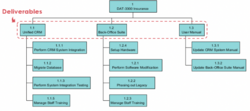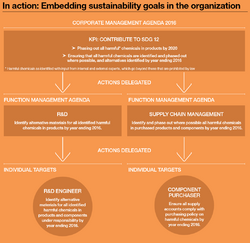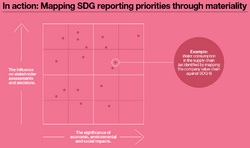Implementation of the SDGs in the Construction Industry
| Line 96: | Line 96: | ||
The importance of reporting and communication means that the companies have to discuss performance with regards to expectations set by the SDGs, and also align disclosures with the language of the SDGs to have a common dialogue among stakeholders.<ref name="sdgc">http://sdgcompass.org/wp-content/uploads/2015/12/019104_SDG_Compass_Guide_2015.pdf</ref> | The importance of reporting and communication means that the companies have to discuss performance with regards to expectations set by the SDGs, and also align disclosures with the language of the SDGs to have a common dialogue among stakeholders.<ref name="sdgc">http://sdgcompass.org/wp-content/uploads/2015/12/019104_SDG_Compass_Guide_2015.pdf</ref> | ||
| + | |||
| + | ==== Reporting in the construction industry ==== | ||
| + | |||
| + | Figure XX shows a materiality matrix conducted by the large Dutch contractor company, Royal BAM Group, and displays the prioritisation of matters based on their relative importance to BAM and to BAM’s stakeholders. For this materiality matrix BAM employees and stakeholders were asked to identify the potential impacts of certain matters, within the timeframe 2016-2020. The BAM employees evaluated the impacts based on their known or potential effects on BAM’s activities, products, services and relations, both within and outside of BAM, and the stakeholders identified and prioritised impacts on themselves and society. | ||
== Benefits == | == Benefits == | ||
Revision as of 17:40, 12 June 2017
In September 2015, 193 world leaders came together with a vision to transform our world to the better. They came to an agreement of 17 global goals for sustainable development (SDGs), with the aim to make an end to extreme poverty, inequality and climate change by 2030. In the pursuit of reaching these goals, it is inevitable for business to take action. One essential thought behind these goals is to make them famous, so that we all have a common goal and know what we are fighting for.
The building industry is responsible for 30% of the total global resources, 40% of global energy consumption and up to 30% of the total global greenhouse gases. In addition, the building industry is considered to be the industry that could potentially reduce its energy consumption with the lowest cost. However, the question is how to implement the SDGs in construction.
The SDG compass presents five steps that assist companies in maximizing their contribution to the SDGs: understanding the SDGs, defining priorities, goal setting, integrating sustainability and reporting and communicating.
Contents |
History
SDG compass
Understanding the SDGs
Countries are struggling to translate the SDGs into meaningful and efficient action at the national level. They all need to identify what policy implication of the SDGs are for them. Therefore, some countries report, they have not made much progress in terms of taking action. It is, however, crucial for the implementation of the goals, countries learn from each other’s experiences.
Goals and targets will support or conflict one another, depending on geography, governance arrangements and technology. It is important to understand the interactions between goals and targets, identifying where key trade-offs lie, and also where different goals reinforce each other in order to develop smart policies. However, having different ministries and planning agencies discussing priorities is likely to be an unruly process. This is where a common language and framework may come in handy.[1]
In an interview with UN Tribune, Martin Edwards said: “I worry about promising action on climate while promising sustained economic growth and full employment while increasing access to energy all at the same time. We might not be able to get everything here, so our attempt to advance some goals might come at the expense of others.”[2]
The initial step for every business is to familiarize themselves with the SDGs and understand the opportunities and responsibilities they represent to the business. By aligning their priorities with the SDGs, companies avoid being exposed to growing legal and reputational risks. Furthermore, they will improve trust among stakeholders and resilience to costs or requirements imposed by future legislation.
The SDGs are expected to be an extremely helpful tool in the creation of more effective partnerships with governments, civil society organizations and other companies. This is because of the common language the SDGs create, which help companies communicate in a more consistent and effective way with stakeholders about their impact and performance. [3]
Defining priorities

The 17 SDGs represent targets and goals which aim towards a somehow perfect world, but not all of them are equally relevant for a company. Each individual company should conduct an assessment on the current, potential, positive and negative impacts they have on the SDGs and the likelihood of future ones. A way to conduct this assessment is by doing a high-level mapping of their value chain, where areas with high likelihood of either negative or positive impacts on the issues that the SDGs represent are identified, see figure XX.[3]
To map high impact areas, certain tools and methodologies are available:[3]
- Life Cycle Assessment (LCA) methodologies
- Environmentally-extended input-outpot (EEIO) models
Some tools can be applied to specific SDGs:[3]
- GHG Protocol Scope 3 Evaluator
- The social Hotspots Database
- The Human Rights and Bussiness Country Guide
- WBCSD Global Water Tool
- Poverty Footprint Tool

For each of the high impact areas indicators that most adequately express the relationship between a company’s activities and the impact on sustainable development, need to be identified, in order to track performance over time. To understand which data to collect, The Logic Model can be used, see Figure XX. A company should then have an understanding of its main impacts on sustainable development, and therefore be able to define priorities across the SDGs.[3]
Priorities in the construction industry
Governments around the world are committed to improve resource efficiency and sustainability, which in the building industry includes certain aspects.
One of these aspects is, that the construction industry in the UK consumes more than 400 million tonnes of material a year. 32% of landfill waste comes from the construction and demolition and 13% of products delivered to construction sites are being sent directly to landfill without being used. It is therefore important to prepare a site waste management plan to reduce the waste. This plan should describe how the materials can be managed efficiently, and how to re-use and recycle the materials. [4]
Another important aspect, is that buildings are responsible for 40% of energy consumption and 36% of CO2 emissions in the EU. Old buildings generally need remarkably more heating oil than new buildings, and the total EU energy consumption could be reduced by 5-6% and CO2 emissions lowered by about 5%. In order to realize this, laws for energy performance of buildings are created all over the world. [5]
Eventually, it is important to mention the focus on housing and regeneration, including homelessness, special needs housing, public sector stock and vacancy rates.
Setting goals
After the impact assessment and prioritization, a helpful tool to driving good performance is to set specific, measurable and time-bound sustainability goals. In the SDG Compass, goal setting consists of four actions:[3]
- Define scope of goals and select KPIs
- Define baseline and select goal type
- Set level of ambition
- Announce commitment to SDGs
It is essential to select key performance indicators (KPIs) that are specific, measurable and time-bound targets in order to measure progress. When the KPIs are selected, the baseline can be tied to a particular point in time or a particular period in time. In addition, the goals can be absolute goals, which take only the KPI into account, or they can be relative goals, which compare the KPI to a unit of output. However, the value of ambition of the goals are recommended to be considered carefully. Ambitious goals tend to result in greater impacts and better performance in comparison with more modest goals. Finally, making some or all of the company’s goals public, may inspire employees and business partners, and result in a constructive dialogue with external stakeholders.[3]
Setting goals in the building industry
The building industry is one of the most important industries to improve, when considering the SDGs. One example of a company, that has announced ambitious and specific goals, is the largest US contractor, Bechtel. They have announced the following goals, which they aim to realize by 2030:[6]
- Contribute 100 ideas to help achieve the SDGs
- Improve resilience of 5,000,000 people to natural hazards
- Use sustainable material alternatives to reduce their environmental footprint on 100 percent of their key projects and non-project facilities
- Engage 100 percent of their key suppliers to promote sustainability in the delivery of materials and/or services, and preventing modern-day slavery, including their own supply chains
Integrating

After having identified the specific KPIs and set goals for the company’s strategic priorities, the next task is to integrate it into the core business. The SDG compass describes three actions, which can be undertaken in order to accomplish this:[3]
- Anchoring sustainability goals within the business
Active leadership by the CEO and senior managers is important to succeed with organizational change. They need to create a shared understanding within the company of how the SDGs can be achieved.
- Embed sustainability across all functions
It is essential to ensure support and ownership of corporate functions such as R&D, Business Development, Supply Management, operations and human Resources. Some companies have established cross-functional sustainability councils, boards or task forces. Figure XX illustrates the integration of sustainability through the company’s functions.
- Engage in partnership
At least three different types of partnerships between companies exist. 1) Companies in the value chain can combine complementary skills, technologies, and resources. 2) Industry leaders can come together to raise standards and practices across the entire industry. 3) Complex challenges can be tackled by multi-stakeholder partnerships. (governments, private sector and civil society organizations)
Engaging in partnerships in the construction industry
To meet the challenges of sustainable construction it is crucial to enlisting help of all stakeholders throughout the entire value chain, including design, construction, operation and maintenance. The large French contractor company, Bouygues Construction, elaborate on their website, that they create customised partnerships based on specific goals, to obtain important results on the environmental respect level and to contribute to the performance of customers.
They furthermore give an example of how partnerships provide significant results. This example tells, how they entrusted the manufacture of sheathing to a supplier who was able to manufacture the equipment on site, and adapt its production to the site’s needs. This happened during the construction of the underground high-voltage power line between Boutre and Trans (PACA), and resulted in 87,525 kilometres of transportation avoided and 5% gain in productivity for the installation.[7]
reporting and communicating

Over the last decade, it has become important to report and communicate progress with regards to the SDGs to stakeholders. Companies use internationally recognized stardards, such as the standard offered by GRI, for sustainability reporting. GRI has defined ten principles for sustainability reporting to help companies prepare high-quality information on the issues that matter: stakeholder inclusiveness, sustainability context, materiality, completeness, balance, comparability, accuracy, timeliness, clarity and reliability. Figure XX shows a mapping of SDG reporting priorities through materiality. Material issues reflect a company’s significant economic, environmental and social impacts – both negative and positive.
The importance of reporting and communication means that the companies have to discuss performance with regards to expectations set by the SDGs, and also align disclosures with the language of the SDGs to have a common dialogue among stakeholders.[3]
Reporting in the construction industry
Figure XX shows a materiality matrix conducted by the large Dutch contractor company, Royal BAM Group, and displays the prioritisation of matters based on their relative importance to BAM and to BAM’s stakeholders. For this materiality matrix BAM employees and stakeholders were asked to identify the potential impacts of certain matters, within the timeframe 2016-2020. The BAM employees evaluated the impacts based on their known or potential effects on BAM’s activities, products, services and relations, both within and outside of BAM, and the stakeholders identified and prioritised impacts on themselves and society.
Benefits
Limitations
References
Several references are directly linked in the text through its key word.
- ↑ https://www.weforum.org/agenda/2016/07/understanding-interactions-is-key-to-making-the-sdgs-a-success/
- ↑ http://untribune.com/understanding-the-sustainable-development-goals-five-key-questions
- ↑ 3.00 3.01 3.02 3.03 3.04 3.05 3.06 3.07 3.08 3.09 3.10 3.11 3.12 http://sdgcompass.org/wp-content/uploads/2015/12/019104_SDG_Compass_Guide_2015.pdf
- ↑ https://www.designingbuildings.co.uk/wiki/Site_waste_management_plan
- ↑ https://ec.europa.eu/energy/en/topics/energy-efficiency/buildings
- ↑ http://blog.bechtel.com/build-100/may-2017/innovation-and-sustainability/
- ↑ http://www.bouygues-construction.com/en/sustainable-development/listening-our-customers-and-partners#fc-7934